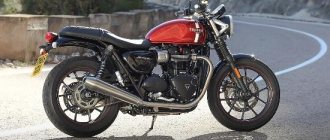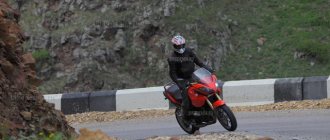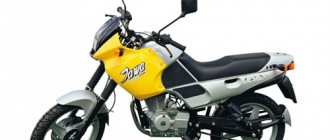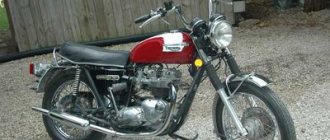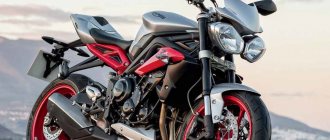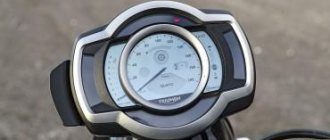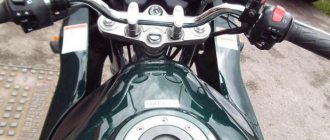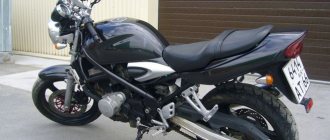TRIUMPH SPRINT ST/GT
In 2005, Triumph launched the updated “sport tourer” Sprint ST, created around a 1050 cc in-line “three” with a capacity of 12S (in fact, once again a modernized unit, the design of which originates from the early nineties). At the same time, it was obvious even to a blind person that the Hinckley factory took its number one competitor, the 2010 Honda VFR800F “sport station wagon,” as an example to follow: to run errands, to circle the track, and to boldly set off towards the horizon.
However, along with all the advantages, the “British” also adopted certain mistakes of the “Japanese” (for example, a battery of mufflers located under the saddle, which greatly limited the choice of luggage bags), which, taking into account the general trends of the motor market - less sports, more tourism - seriously affected sales figures. Therefore, already in 2010, the “street” ST was ousted from the assembly line by the “highway-long-distance” GT.
STORY
2005 The appearance of a seriously redesigned asphalt “tourist” Sprint ST with an injection in-line “three” with a volume of 1050 cm3 and a power of 125 hp, the design of which was born in the early nineties. Main features: cantilever rear wheel mount and underseat muffler.
2010 The British present a long-range version of the Sprint GT. The exhaust system moves to the right side. Side cases with a capacity of 31 liters each become part of the standard equipment. The aluminum subframe has been replaced with a more durable steel one. The monoshock absorber has remote spring preload adjustment. The swingarm grows in length, which increases the wheelbase to 1565 mm (+95 mm). But the engine becomes more powerful by 5 hp. The ST variant disappears from the brand's showrooms at the end of the year.
2013 To stir up interest in the aging model, Triumph releases a special version of the GT SE, which actually displaces the “standard” from the lineup. It is distinguished by the presence of a central case (useful volume has increased to 117 liters), heated handles, a gel saddle and a high windshield. However, since 2015, the model was not sold in all markets, and at the end of 2022 it finally retired, leaving no heir.
“Dzhitishka” was distinguished, first of all, by a muffler mounted on the right side, a set of side cases of 31 liters each, a steel subframe instead of aluminum and an elongated cantilever pendulum, as a result of which not only the issue with luggage was resolved, but at the same time there was no extra legroom at all passenger, but the wheelbase has also increased to 1S6S mm (+9S mm). Apparently, as compensation for the deteriorated maneuverability, the engine was not given an extra 5 hp.
However, there was no avalanche-like demand for the Sprint GT. So just three years later, in order to somehow draw attention to the aging “road car”, the British transformed it into a special version of the GT SE, which was de facto a “standard” with a central trunk (the useful volume increased to 117 liters), “ warm" handles, gel saddle and high windshield.
As you might guess, before the invasion of crossovers, all efforts were in vain. The Sprint family, represented by the GT version, existed until 2022, after which it retired without leaving an heir.
Ride. Always, everywhere and sometimes very far. Especially if you have been looking for a used “vyfer” for a long time for these purposes, but it was scared off by its inflated price tag. The British Sprint of both modifications is generally very close in its design to the VFR of the “Dovtek” times: grumbling, smooth, a little massive and somewhat old-fashioned. And if you like to feel the essence of a motorcycle, and not the shell of arcade games, then the ST and GT, deprived of almost all electronic assistants (ABS and fuel injection do not count) and engine modes, can truly become a “breath of fresh air” for you in a stuffy digital world.”
The best thing about it is the in-line “three” with a volume of 10S0 cm3, which has an impressive reserve of traction at the “bottoms” and sufficient for vigorous overtaking at the “tops”. The ergonomics are relaxed, with a slight forward tilt - so that you can talk about involvement in the control process and the presence of feedback on the steering wheel. But if you suddenly want to light it up, cut the steps on the serpentine road along with the sidewalls of the tires, then Sprint will instantly remind you of its “old-regime” essence: smooth and seamless control in the style of Mike Hailwood suits the “British” much better than the mad rodeo of Marc Marquez.
The presence of a passenger further emphasizes the monoshock's lack of shock damping. This is compensated for by tightening the spring preload (the GT, by the way, is equipped with remote adjustment), but only on the condition that you abandon the idea of bringing your entire house on the road. And it’s very easy to succumb to this temptation - stirrups with panniers with a total capacity of 117 liters! At the same time, you must be sure to remember the maximum permissible load - up to 215 kg on the GT, including driver and passenger.
The influence of the “old school” can be seen throughout the Sprint design.
First of all, in the in-line “three” with a volume of 1050 cm3, which is good and brutal, but requires careful maintenance. As soon as you neglect such seemingly nonsense as warming up, the engine begins to consume oil. At least until it reaches operating temperatures. If so, then in order to avoid problems with the crankshaft main bearings, it makes sense to get into the habit of checking the oil level daily.
One of the Triumph recall campaigns for the Sprint ST and GT models, by the way, related to the lubrication system: due to an error made at the factory, 200 motorcycles in 2010 were equipped with short oil dipsticks. The second time the British invited us to the service was in 2007, when some copies were found to have a faulty front master cylinder (part number T2025498). Well, the third case occurred in 2011, when the British missed the design of the fastening mechanism of the central case (part numbers T2351020 and T2353172): it did not secure the plastic suitcase tightly enough on the platform and gradually became loose, as a result of which the luggage could at some point simply catapult.
To make life easier for the engine and not risk your health with the almost inevitable risk of overheating of the light-alloy cylinder head, do not forget to clean the radiator of the cooling system at least once every two to three years. Just carry out this procedure carefully: small honeycombs are extremely delicate.
The starter overrunning clutch roller is also fragile, which can jam if you try to start the engine with the battery at zero. At best, this will lead to destruction of the starter, at worst - a total “Stalingrad” of the engine due to crushed gears and couplings. Therefore, always keep the battery fully charged and do not overdo it with the starter button if it suddenly becomes difficult for you to crank the crankshaft. A characteristic knock at the bottom of the engine will indicate that the unit is faulty or close to failure.
False neutrals and stubbornness when changing gears, which owners of “liter-fifties” Sprint ST and GT often complain about, appear mainly on untested cars and usually disappear with use. Provided, of course, that the mobility of the hinges and rods of the switching mechanism is normal, and the clutch does not jam when released, this happens. If obstinacy is still present, you can always experiment with oil viscosity within the range recommended by Triumph: 10W-40 or 15W-50, one hundred percent or semi-synthetic.
The effectiveness of the Nissin brakes (both front and rear) is barely enough for a large “tourist”. Like any mechanism, they love caress, cleaning and lubrication: road dirt, dust from pads, rust on pistons and bolts are their constant companions. In addition, from periodic overheating - try to stop flying 400-450 kg with luggage and a passenger! — caliper seals suffer. This means that the brakes need to be cleaned of dirt and oxides at every service, and in some advanced cases, they need to be rebuilt. Of course, it makes sense to replace the “stock” pads with the “evil” version with the NN index and the hoses with reinforced ones. But then you will have to accustom yourself to the fact that the first meters of the journey, while the discs and pads are cold, you need to press the growl gently. Because the inevitable consequence of haste will be warped brake discs.
As far as electrics are concerned, the most complaints come from a failing voltage regulator relay, which causes the expensive generator to die prematurely. At the end of the Sprint assembly line life, the British replaced the original part with an improved version (part number T1304040), but owners much more often vote with their wallets for the alternative relay-regulator ShinDengen SH series, which is equipped with the latest generations of Tiger 800 and Street Triple (part number T1300675) and to install it in the standard Sprint wiring you will need an adapter (part number T2500676).
Those who travel in any weather, from the first to the last snow, have noticed that the place for the optional “anti-theft” is chosen extremely poorly: moisture gets there, disabling the alarm system.
ENGINE
The roots of the in-line “three” inherited by the sports tourer Sprint ST/GT stretch back to the early nineties, when Triumph, revived by John Bloor, introduced its debut tour enduro Tiger 900. And the 1050 cc version, born in 2005, with a power of 125 hp. — this is already the third generation, obtained by increasing the piston stroke of the first injection engine with a volume of 955 cm by 6.4 mm! 1997 model. From him, the “fifty liter” also adopted the need for mandatory warming up, as well as the tendency to consume oil. The gearbox works better, but still sometimes there are false neutrals and stubbornness when shifting. One of the weak points is the starter overrunning clutch roller, which can jam if, for example, you try to start the engine with the battery at zero. What happens because the battery tends to discharge due to a capricious relay regulator.
SUSPENSION
The Showa suspension is technically simple. Among the “excesses”, the only available options are preload adjustment at the front and rear and adjustment of the rebound hydraulics on the monoshock absorber. However, even when clamped, the shock absorber still remains too soft, which is very noticeable in comparison with a rigid fork. Salvation, as always, comes in the form of new springs and valves, or a more advanced alternative (Wilbers type 640 and type 641, for example, or Ohlins STX 46 Adventure TR 703).
BRAKE SYSTEM
The brakes are generally sufficient, although they are limited. You can slightly strengthen their fleece by choosing “sadier” pads and replacing the hoses with reinforced ones. In addition, like any mechanism, Spent ST/GT brakes love caress, cleaning and lubrication: dust from the pads often sticks to the pistons with guides and jams them.
TUNING
Judging by the fact that the SE special version, which appeared in 2013, is de facto a “stuffed standard”, there are no problems with the choice of additional equipment. After all, in the company catalog there are panniers with a total capacity of 117 liters (alas, they leak), a satellite navigator (outdated and overrated), a front fender extension (saves the radiator from dirt flying from under the wheel), and a high windshield (redirects the air flow from chest to head), and a gel saddle (adds comfort). True, there is still not much there. For example, sliders for the frame or wheel axles, grille protection for the radiator, a boot cover for the monoshock absorber or an automatic chain oiler. So you definitely can’t do without third-party companies specializing in accessories for tourists.
Links[edit]
- ^ abcde "Performance Index Winter '12/'13 Edition" (PDF), Motorcycle Consumer News
, Bowtie Magazines, January 2013 - ^ ab "TRIUMPH SPRINT ST (1998-2004) Review". MCN. November 24, 2006. Retrieved October 16, 2022.
- ^ ab "TRIUMPH SPRINT GT 1050 (2010) Review". MCN. June 9, 2010. Retrieved October 16, 2022.
- Triumph Sprint GT Archived May 19, 2010 at the Wayback Machine
- Motorcycles, Triumph. “Sprint GT | Triumph Motorcycles | Triumph motorcycles". www.triumphmotorcycles.co.uk
. Retrieved September 27, 2022. - "TRIUMPH SPRINT ST 1050 (2005) Review". MCN. November 26, 2006. Retrieved October 16, 2022.

